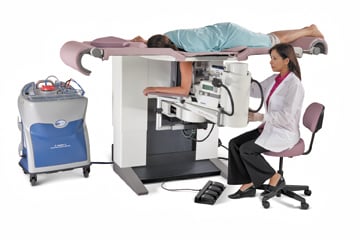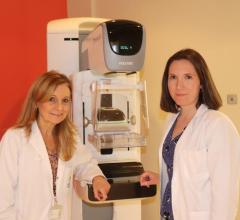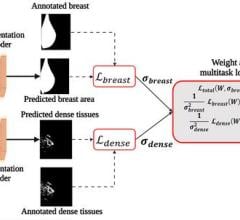
The wider opening and additional arm support of the Maximum Comfort Package make the arm-through procedure easier for patients.
Dartmouth-Hitchcock is a national leader in academic medicine, particularly in evidence-based and patient-centered healthcare, medical research and healthcare policy reform. Dartmouth-Hitchcock Medical Center (DHMC) in Lebanon, New Hampshire, recently adopted a breast biopsy table designed with the goal of improving patient comfort during prone stereotactic biopsy procedures.
Improved Table Design Transforms Patient Experience
According to radiologist Steven Poplack, M.D., co-director of Dartmouth-Hitchcock’s Breast Imaging Program, one of the biggest challenges of stereotactic biopsy procedures is patient discomfort as a result of the prone position.
“Based on my personal experience performing stereotactic biopsy at Dartmouth-Hitchcock Medical Center over the last 18 years, I can say the importance of patient comfort cannot be overstated,” says Dr. Poplack. “Our primary clinical goal is to thoroughly sample the lesion. But the secondary goal is to do so with a minimum of discomfort, so that the patient’s overall experience of the procedure is positive.”
When DHMC first began utilizing its prone stereotactic table in 2005, radiologists and technologists often fielded complaints about patient discomfort unrelated to the biopsy itself. But since the adoption of a new table, known as the Hologic MultiCare Maximum Comfort Package, Dr. Poplack noticed a decrease in patients’ complaints related to the discomfort of the procedure.
“We were used to hearing complaints about neck, rib and back discomfort. But since we added the Comfort Package, we seldom receive that feedback,” says Lead Interventional Technologist Janine Stammers. “The improved design gives us more choice regarding how we can address patient comfort.”
The Maximum Comfort Package is a collection of ergonomically engineered cushions and a new tabletop designed for use with the Hologic Multi-Care Platinum prone stereotactic breast biopsy guidance system. The cushions provide targeted pressure-point support for all types of stereotactic breast biopsy procedures and body types while maintaining optimal positioning and maximum access.
The Maximum Comfort Package consists of a choice of four tabletop cushions. The cushion that is used depends on the patient’s body type, breast size and location of the lesion.
The Standard Access cushion provides the same access as the existing tabletop, but is made of ergonomic memory foam that targets specific pressure points. The Maximum Access cushion is thinner and is useful for positioning patients with high chest wall lesions. The Maximum Comfort cushion consists of multiple layers of foam to ensure comfort, particularly when accessing more anterior lesions. The Arm-Through cushion features a slightly larger opening that allows patients to comfortably fit through the table when accessing high axillary regions.
Dr. Poplack says the design also helped simplify the arm-through procedure. While the technique is useful for accessing lesions located near the axilla, the one-size-fits-all opening on most tables can often restrict access for some patients with physical limitations, and the lack of arm support sometimes contributes to even greater discomfort. But the design includes a new arm-through pad and wider aperture that helps patients comfortably fit their arms and shoulders through the table, along with an arm rest for increased support and stability.
Patient Comfort Improves Efficiency
According to Dr. Poplack, increasing comfort not only improves the patient experience, it also improves the speed and efficiency for a majority of his stereotactic procedures. When patients are more comfortable, they can often settle into the correct position more quickly. As a result, for most patients, technologists saw their procedure set-up time decrease by nearly half, going from five minutes to less than three minutes. In addition, greater patient comfort leads to less motion during the procedure, and radiologists are seeing a decline in the number of repeat exposures required.
Increased Access to Minimally Invasive Procedures
By increasing comfort and providing more options, Dr. Poplack believes they can offer the benefits of minimally invasive breast biopsies to more women. In addition to the cushions, the design features three new interchangeable drop-in apertures, which allows for customized positioning and helps radiologists employ needle approaches that may not have been possible in the past.
“We are now able to successfully biopsy nearly all mammographically visible lesions,” says Dr. Poplack. “The small number of cases that were not amenable to stereotactic biopsy due to small breast size and posterior lesion location has been decreased even further.”
This case study was supplied by Hologic. This interview includes the individual comments and opinions of Steven Poplack, M.D., co-director, Breast Imaging Program at Dartmouth-Hitchcock Medical Center in Lebanon, New Hampshire. None of Dr. Poplack’s comments should be considered to be an endorsement of any product or service by Dartmouth-Hitchcock Medical Center. Hologic and MultiCare are trademarks and/or registered trademarks of Hologic Inc. and/or its subsidiaries in the Unites States and/or other countries.


 April 02, 2024
April 02, 2024 








